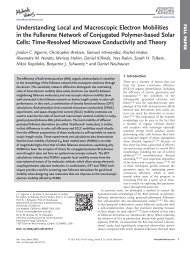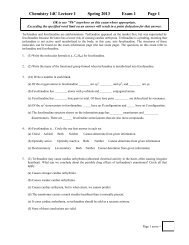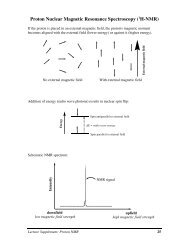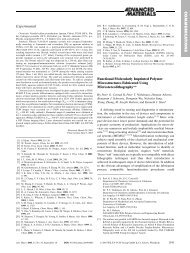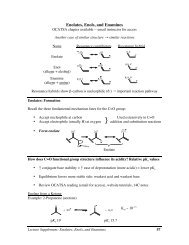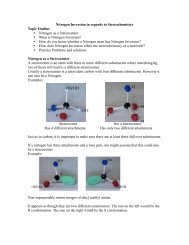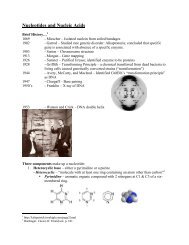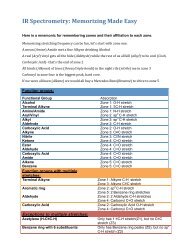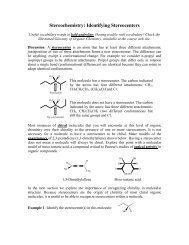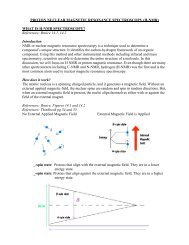Protein Detection Methods on Blots - UCLA Chemistry and ...
Protein Detection Methods on Blots - UCLA Chemistry and ...
Protein Detection Methods on Blots - UCLA Chemistry and ...
You also want an ePaper? Increase the reach of your titles
YUMPU automatically turns print PDFs into web optimized ePapers that Google loves.
A Brief Review of Other Notable <str<strong>on</strong>g>Protein</str<strong>on</strong>g><br />
<str<strong>on</strong>g>Detecti<strong>on</strong></str<strong>on</strong>g> <str<strong>on</strong>g>Methods</str<strong>on</strong>g> <strong>on</strong> <strong>Blots</strong><br />
Biji T. Kurien <strong>and</strong> R. Hal Scofield<br />
Summary<br />
Chapter 56<br />
Several methods have been used for detecting proteins <strong>on</strong> membranes. These include the use of quantum<br />
dot luminescent labels, oxyblot immunochemical detecti<strong>on</strong>, polymer immunocomplexes, “coupled”<br />
probing approach, in situ renaturati<strong>on</strong> of proteins for detecting enzyme activities in crude or purified<br />
preparati<strong>on</strong>s, immunochromatographic assay, western-phosphatase assay, <strong>and</strong> the use of C<strong>on</strong>go red dye, a<br />
cosmetic color named Alta, Pro-Q Emerald 488 dye, or amine-reactive dye in combinati<strong>on</strong> with alkaline<br />
phosphatase <strong>and</strong> horseradish peroxidase–antibody c<strong>on</strong>jugates for the simultaneous trichromatic fluourescence<br />
detecti<strong>on</strong> of proteins. Several methods have been used to improve the detecti<strong>on</strong> of proteins <strong>on</strong><br />
membranes, including glutaraldehyde treatment of nitrocellulose blots, eliminati<strong>on</strong> of keratin artifacts in<br />
immunoblots probed with polycl<strong>on</strong>al antibodies, <strong>and</strong> the washing of immunoblots with excessive water<br />
<strong>and</strong> manipulati<strong>on</strong> of Tween-20 in wash buffer. These methods are briefly reviewed in this chapter.<br />
Key words: <str<strong>on</strong>g>Protein</str<strong>on</strong>g> detecti<strong>on</strong> , Membranes , Background reducti<strong>on</strong> , Dyes , Quantum dot luminescent<br />
labels<br />
1. Two-Dimensi<strong>on</strong>al<br />
Oxyblot<br />
Oxidative modificati<strong>on</strong> of proteins by free radicals has been<br />
implicated in several diseases including Alzheimer’s disease<br />
(AD) (1, 2) . <str<strong>on</strong>g>Protein</str<strong>on</strong>g> carb<strong>on</strong>yl formati<strong>on</strong> is c<strong>on</strong>sidered to be<br />
a detectable marker of protein oxidati<strong>on</strong> <strong>and</strong> it is increased in<br />
AD. The level of carb<strong>on</strong>yls is higher in areas where the histopathology<br />
of the disease is more pr<strong>on</strong>ounced. Formati<strong>on</strong><br />
Biji T. Kurien <strong>and</strong> R. Hal Scofield (eds.), <str<strong>on</strong>g>Methods</str<strong>on</strong>g> in Molecular Biology, <str<strong>on</strong>g>Protein</str<strong>on</strong>g> Blotting <strong>and</strong> <str<strong>on</strong>g>Detecti<strong>on</strong></str<strong>on</strong>g>, vol. 536<br />
© Humana Press, a part of Springer Science + Business Media, LLC 2009<br />
DOI: 10.1007/978-1-59745-542-8_55<br />
557
558 Kurien <strong>and</strong> Scofield<br />
1.1. <str<strong>on</strong>g>Protein</str<strong>on</strong>g> Carb<strong>on</strong>yl<br />
Derivatizati<strong>on</strong><br />
1.2. Oxyblot Immunochemical<br />
<str<strong>on</strong>g>Detecti<strong>on</strong></str<strong>on</strong>g><br />
of carb<strong>on</strong>yls is thought to be due to reactive oxygen species<br />
(ROS)-mediated oxidati<strong>on</strong> of amino acid side chains or by covalent<br />
binding to lipid peroxidati<strong>on</strong> products or glycoxidati<strong>on</strong><br />
(3) . Unless the oxidative modificati<strong>on</strong> process brings about protein<br />
aggregati<strong>on</strong> resulting in depositi<strong>on</strong> of proteolysis-resistant<br />
protein aggregates (4) , oxidized proteins are more susceptible<br />
to degradati<strong>on</strong> by specific proteases (5) . Increased producti<strong>on</strong><br />
of ROS <strong>and</strong> oxidative modificati<strong>on</strong> of proteins in the brain has<br />
been noted in AD pathology (2) , thus suggesting the involvement<br />
of protein oxidati<strong>on</strong> in the neurogenerative processes<br />
peculiar to AD.<br />
By coupling two-dimensi<strong>on</strong>al (2D) gel fingerprinting of<br />
oxidized proteins <strong>and</strong> immunochemical detecti<strong>on</strong> of protein<br />
carb<strong>on</strong>yls, the identificati<strong>on</strong> of protein targets of oxidative<br />
modificati<strong>on</strong>, which could help in establishing a relati<strong>on</strong>ship<br />
between oxidative modificati<strong>on</strong> <strong>and</strong> neur<strong>on</strong>al death in AD, has<br />
been achieved (6) . Since this procedure was laborious, resulting<br />
in identificati<strong>on</strong> of <strong>on</strong>ly a few oxidized proteins Castegna et al.<br />
(2) coupled 2D fingerprinting with immunological detecti<strong>on</strong><br />
of carb<strong>on</strong>yls <strong>and</strong> mass spectrometric identificati<strong>on</strong> of proteins.<br />
Such an approach led them to identify specific protein targets of<br />
oxidative modificati<strong>on</strong>.<br />
To each brain sample (obtained at autopsy from AD patients),<br />
2,4-dinitrophenylhydraz<strong>on</strong>e (DNP)/HCl was added (for<br />
mass spectrometry analysis <strong>on</strong>ly HCl was used). Samples<br />
were precipitated with ice-cold trichloroacetic acid following<br />
a brief incubati<strong>on</strong>. Samples were centrifuged <strong>and</strong> the precipitate<br />
was resolubilized in urea. DNPH-treated samples of<br />
brain proteins from AD <strong>and</strong> c<strong>on</strong>trol subjects were used for<br />
<strong>on</strong>e-dimensi<strong>on</strong>al (1D) <strong>and</strong> 2D immunoblotting analysis of<br />
protein carb<strong>on</strong>yls (6) .<br />
The 1D <strong>and</strong> 2D gels were electrotransferred to nitrocellulose<br />
or PVDF. After blocking with bovine serum albumin,<br />
the membranes were incubated with anti-DNP polycl<strong>on</strong>al<br />
antibody. Following additi<strong>on</strong> of appropriate alkaline phosphatase<br />
sec<strong>on</strong>dary antibody the blots were developed with<br />
NBT (nitro blue tetrazolium)/BCIP (5-bromo-4-chloro-<br />
3-indolyl phosphate) substrate. The blots were dried <strong>and</strong><br />
scanned. Matrix-assisted laser desorpti<strong>on</strong>/i<strong>on</strong>izati<strong>on</strong> time of<br />
flight (MALDI-TOF) mass spectrometry of trypsin-digested<br />
spots from a Coomassie Blue-stained 2D gel was also carried<br />
out for protein identificati<strong>on</strong> (2) . Using this procedure the<br />
authors identified creatine kinase BB, glutamine synthase,<br />
<strong>and</strong> ubiquitin carboxy-terminal hydrolase L-1 as the targets<br />
of oxidative modificati<strong>on</strong> in AD.
2. Bioc<strong>on</strong>jugati<strong>on</strong><br />
of Quantum Dot<br />
Luminescent<br />
Probes for Western<br />
Blot Analysis<br />
A Brief Review of Other Notable <str<strong>on</strong>g>Protein</str<strong>on</strong>g> <str<strong>on</strong>g>Detecti<strong>on</strong></str<strong>on</strong>g> <str<strong>on</strong>g>Methods</str<strong>on</strong>g> <strong>on</strong> <strong>Blots</strong> 559<br />
<str<strong>on</strong>g>Detecti<strong>on</strong></str<strong>on</strong>g> of multiple antigens is usually d<strong>on</strong>e by stripping <strong>and</strong><br />
reprobing a blot with transferred protein. Krajewski et al. (7)<br />
showed that it is possible to detect multiple antigens <strong>on</strong> a single<br />
blot without stripping off antibodies that have been added first<br />
by employing sequential reacti<strong>on</strong>s. By employing multiple fluorescent<br />
probes made from small organic dye molecules it is also<br />
possible to detect multiple antigens <strong>on</strong> a single blot without<br />
stripping off antibodies (8) ( see Chapters “‘Rainbow’ Western<br />
Blotting” <strong>and</strong> “Multiple Antigen <str<strong>on</strong>g>Detecti<strong>on</strong></str<strong>on</strong>g> Western Blotting”).<br />
However, such probes have several limitati<strong>on</strong>s. Most of these<br />
problems can, however, be eliminated by the use of quantum dot<br />
(QD) luminescent labels (9) .<br />
QDs are semic<strong>on</strong>ductor nanoparticles (e.g., CdSe, Inp, InAs)<br />
(having diameters of 2–10 nm) whose fundamental physical properties<br />
are influenced by quantum c<strong>on</strong>finement effects (10) . QDs<br />
display absorpti<strong>on</strong> <strong>and</strong> emissi<strong>on</strong> peaks that progressively change<br />
to l<strong>on</strong>ger wavelengths with increasing particle size. Compared<br />
with st<strong>and</strong>ard fluorescent dyes QDs have significant advantages.<br />
Dyes, for example, have narrow absorpti<strong>on</strong> b<strong>and</strong>s, <strong>and</strong> therefore<br />
it is difficult to excite several colors with a single excitati<strong>on</strong><br />
source. In additi<strong>on</strong>, the broad spectral overlap between emissi<strong>on</strong>s<br />
of dyes necessitates complex mathematical analysis of the<br />
data. In comparis<strong>on</strong>, QDs possess a narrow, tunable, symmetric<br />
emissi<strong>on</strong> spectrum allowing a larger number of probes within a<br />
detectable spectral regi<strong>on</strong>. A single light source can be used to<br />
excite different size populati<strong>on</strong>s of QDs. This makes it possible to<br />
develop simpler <strong>and</strong> more cost-effective instrumentati<strong>on</strong> for multiplex<br />
detecti<strong>on</strong> of biomolecules. Compared with organic dyes,<br />
QDs are c<strong>on</strong>siderably more stable against photobleaching (11) .<br />
This property is important, especially for imaging applicati<strong>on</strong>s,<br />
where the high photostability of QDs permits real-time m<strong>on</strong>itoring<br />
of intracellular processes over l<strong>on</strong>ger periods of time (12) .<br />
QDs show large Stokes shifts (the difference between the maximum<br />
absorbance <strong>and</strong> emissi<strong>on</strong> wavelengths). In c<strong>on</strong>trast to the<br />
use of fluorescent proteins (e.g., green fluorescent protein), this<br />
property permits the target signals to be clearly separated from<br />
autofluorescence <strong>and</strong> thus enables the entire emissi<strong>on</strong> spectra to<br />
be collected.<br />
Makrides et al. (9) show a novel method of c<strong>on</strong>jugating antibodies<br />
(primary or sec<strong>on</strong>dary) to QD, allowing the easy generati<strong>on</strong><br />
of QD-based probes for the multiplex detecti<strong>on</strong> of proteins<br />
in western blots. They used the immunoglobulin G (IgG)binding<br />
Z domain, which is based <strong>on</strong> the B domain of Staphylococcus<br />
aureus protein A. The Z-affinity tag (6.5 kDa) is highly<br />
specific for its lig<strong>and</strong>, IgG Fc, <strong>and</strong> can easily be purified by affinity
560 Kurien <strong>and</strong> Scofield<br />
3. Simultaneous<br />
Trichromatic<br />
Fluourescence<br />
<str<strong>on</strong>g>Detecti<strong>on</strong></str<strong>on</strong>g> of<br />
<str<strong>on</strong>g>Protein</str<strong>on</strong>g>s <strong>on</strong> Western<br />
<strong>Blots</strong> Using an<br />
Amine-Reactive<br />
Dye in Combinati<strong>on</strong><br />
with Alkaline<br />
Phosphatase <strong>and</strong><br />
Horseradish Peroxidase–Antibody<br />
C<strong>on</strong>jugates<br />
chromatography using IgG-sepharose. It has been shown earlier<br />
that the divalent ZZ domain showed ten times higher affinity for<br />
its IgG lig<strong>and</strong> compared with the m<strong>on</strong>ovalent Z domain. The<br />
authors designed a ZZ protein fused to a peptide that is biotinylated<br />
in vivo (by biotin protein ligase, the birA gene product),<br />
followed by a six-histidine tag. Bacteria were used to produce the<br />
biotinylated ZZ tag <strong>and</strong> was purified over a m<strong>on</strong>omeric avidin<br />
or Ni 2+ -NTA column <strong>and</strong> attached to streptavidin-coated QDs.<br />
Such a technology enables the biospecific coupling of any antibody<br />
to the functi<strong>on</strong>alized QDs (9) .<br />
<str<strong>on</strong>g>Protein</str<strong>on</strong>g>s electrotransferred to PVDF membranes were<br />
washed with TBST (Tris-buffered saline c<strong>on</strong>taining 0.1% Tween-<br />
20) <strong>and</strong> then blocked. The membranes were then incubated with<br />
the diluted primary antibody in blocking buffer <strong>and</strong> washed. The<br />
membrane was then incubated with QD 565 -ZZ or QD 655 -ZZ nanoparticles<br />
c<strong>on</strong>jugated to sec<strong>on</strong>dary antibody. Following washing<br />
the protein b<strong>and</strong>s were visualized using l<strong>on</strong>g-wavelength ultraviolet<br />
irradiati<strong>on</strong> (9) .<br />
The authors detected two different proteins simultaneously<br />
<strong>on</strong> the same blot by probing first with primary antibodies, followed<br />
by incubati<strong>on</strong> with QD 565 -ZZ or QD 655 -ZZ nanoparticles<br />
or both, c<strong>on</strong>jugated to sec<strong>on</strong>dary antibodies (9) .<br />
Duplicate gels are often required, for general protein staining<br />
<strong>and</strong> the other for immunoblotting, for c<strong>on</strong>currently visualizing<br />
total protein profile <strong>and</strong> a specific protein by immunoblotting.<br />
It is also possible to immunodetect two antigens by stripping the<br />
antibody complexes from the original blot <strong>and</strong> reprobing with<br />
another antibody. However, changes in gel size relative in the<br />
blot occur as a result of gel shrinkage, swelling, or other artifacts<br />
of electrophoresis, making definitive identificati<strong>on</strong> of protein<br />
b<strong>and</strong>s/spots unreliable.<br />
Martin et al. (13) report the use of an improved trichromatic<br />
detecti<strong>on</strong> procedure using 2-methoxy-2,4-diphenyl-2(2 H )furan<strong>on</strong>e<br />
(MDFF) for the detecti<strong>on</strong> of total protein profiles, a<br />
red-fluorogenic substrate 9 H -(1,3-dichloro-9.9-dimethylacridin-2-<strong>on</strong>e-7-yl)<br />
phosphate (DDAO phosphate) to detect alkaline<br />
phosphatase c<strong>on</strong>jugates, <strong>and</strong> Amplex gold reagent to detect<br />
horseradish peroxidase c<strong>on</strong>jugates. The authors refer to this<br />
method as the “DyeChrome Double western blot stain.” Using<br />
this procedure two different targets can be identified, when using<br />
c<strong>on</strong>venti<strong>on</strong>al enzyme c<strong>on</strong>jugates or sec<strong>on</strong>dary antibodies, as l<strong>on</strong>g<br />
as primary antibodies from two different species are employed in
4. A New Immunoblotting<br />
Method<br />
Using Polymer<br />
Immunocomplexes:<br />
<str<strong>on</strong>g>Detecti<strong>on</strong></str<strong>on</strong>g><br />
of Tsc1 <strong>and</strong> Tsc2<br />
Expressi<strong>on</strong> in Various<br />
Cultured Cell<br />
Lines<br />
A Brief Review of Other Notable <str<strong>on</strong>g>Protein</str<strong>on</strong>g> <str<strong>on</strong>g>Detecti<strong>on</strong></str<strong>on</strong>g> <str<strong>on</strong>g>Methods</str<strong>on</strong>g> <strong>on</strong> <strong>Blots</strong> 561<br />
the analysis. For instance, <strong>on</strong>e primary antibody could be raised<br />
in mouse while the other in rabbit. However, by using Zen<strong>on</strong><br />
antibody labeling technology (13) two antibodies from the same<br />
species could be utilized <strong>on</strong> the same blot.<br />
Following protein blotting, membranes were equilibrated in<br />
sodium borate buffer. MDPF in sodium borate buffer was added to<br />
the blot after removing the buffer. Following several washing steps<br />
the membrane was blocked. Both primary antibodies were prepared<br />
<strong>and</strong> added to the membrane after the blocking step. Sec<strong>on</strong>dary<br />
antibodies were added after washing the membrane. DDAO<br />
phosphate <strong>and</strong> Amplex gold dye were added <strong>and</strong> signals were visualized<br />
using ultraviolet epi-illuminati<strong>on</strong> <strong>and</strong> photography.<br />
In biological research the detecti<strong>on</strong> of protein expressi<strong>on</strong> is important<br />
for functi<strong>on</strong>al analysis of gene products. One of the most useful<br />
c<strong>on</strong>venti<strong>on</strong>al methods for this purpose is western blotting. It<br />
is, however, sometimes difficult to get antibodies with sufficiently<br />
high titer, especially when effective antigenic regi<strong>on</strong>s are unknown.<br />
High c<strong>on</strong>centrati<strong>on</strong>s of sec<strong>on</strong>dary antibodies <strong>and</strong>/or l<strong>on</strong>g exposure<br />
times are essential when using low titer antibodies. In such a<br />
scenario sec<strong>on</strong>dary antibodies sometimes have a tendency to bind<br />
to membranes directly, leading to n<strong>on</strong>specific b<strong>and</strong>s.<br />
Fukuda et al. (14) use a polymer immunocomplex method<br />
to effectively reduce the background in immunostaining of tissue<br />
secti<strong>on</strong>s <strong>and</strong> also to improve the specificity <strong>and</strong> sensitivity of western<br />
blotting. The authors obtained low titer rabbit antibodies<br />
against tuberous sclerosis proteins (Tsc1 <strong>and</strong> Tsc 2). While they<br />
obtained high background binding at first using these antibodies,<br />
they have used the polymer immunocomplex method to reduce<br />
background binding by these antibodies.<br />
In this method, polycl<strong>on</strong>al primary or antigen preabsorbed<br />
antibodies were diluted <strong>and</strong> mixed with Envisi<strong>on</strong> polymer<br />
(DAKO) to generate immunocomplexes of primary <strong>and</strong> sec<strong>on</strong>dary<br />
antibodies. This polymer is an immunological reagent in<br />
which sec<strong>on</strong>dary antibodies are c<strong>on</strong>jugated with several horseradish<br />
peroxidase molecules (HRP) via dextran polymer. Following<br />
this, normal rabbit serum was added <strong>and</strong> mixed with antibody<br />
soluti<strong>on</strong>s in order to mask the “free” antigen binding sites of<br />
Fab domains of sec<strong>on</strong>dary antibodies. The soluti<strong>on</strong> was applied<br />
to blocked membranes. The authors used biotinylated speciesspecific<br />
sec<strong>on</strong>dary antibodies <strong>and</strong> HRP-c<strong>on</strong>jugated streptavidin<br />
for traditi<strong>on</strong>al biotin–streptavidin detecti<strong>on</strong> following washing of<br />
the membranes.
562 Kurien <strong>and</strong> Scofield<br />
5. Washing of<br />
Immunoblots with<br />
Excessive Water<br />
<strong>and</strong> Manipulati<strong>on</strong><br />
of Tween-20 in<br />
Wash Buffer for<br />
Reducing Background<br />
in Western<br />
Blotting<br />
6. Eliminati<strong>on</strong> of<br />
Keratin Artifacts<br />
in Immunoblots<br />
Probed with Polycl<strong>on</strong>al<br />
Antibodies<br />
There are some important steps that need to be taken for avoiding<br />
high background staining <strong>and</strong> unacceptable results. Wu et al. (15)<br />
show that of all other factors that can cause high background, inefficient<br />
washing of the membrane is the main cause. In additi<strong>on</strong>, they<br />
use a lower Tween-20 c<strong>on</strong>centrati<strong>on</strong> (0.02–0.005%) in the buffer<br />
for the reacti<strong>on</strong> with antibody <strong>and</strong> a higher c<strong>on</strong>centrati<strong>on</strong> (0.05%)<br />
in the phosphate buffered saline-Tween-20 (PBST) wash buffer.<br />
Following st<strong>and</strong>ard electrophoresis <strong>and</strong> blotting to presoaked<br />
Immobil<strong>on</strong>-P membrane (Millipore, Bedford, MA, USA) the<br />
membrane was blocked <strong>and</strong> incubated with primary antibody.<br />
The major changes to st<strong>and</strong>ard immunoblotting occur from this<br />
stage <strong>on</strong>ward, mainly in membrane washing <strong>and</strong> in the compositi<strong>on</strong><br />
of buffer used for diluting antibody. The membrane was<br />
rinsed five times with distilled or dei<strong>on</strong>ized water followed with<br />
<strong>on</strong>e 5-min wash with PBST. The authors have found that five<br />
rinses are enough to remove unbound antibody <strong>and</strong> the 5-min<br />
wash with the buffer was sufficient to make the pH <strong>and</strong> i<strong>on</strong>ic<br />
strength appropriate for interacti<strong>on</strong> with antibody. The wash after<br />
sec<strong>on</strong>dary antibody incubati<strong>on</strong> was also repeated similarly.<br />
The authors report better background reducti<strong>on</strong> using the<br />
chemiluminiscence technique with their method of immunodetecti<strong>on</strong><br />
compared with that obtained with classical immunodetecti<strong>on</strong><br />
with chemiluminiscence. There are two advantages by<br />
washing with water coupled with a single buffer wash compared<br />
with the c<strong>on</strong>venti<strong>on</strong>al washing with buffer al<strong>on</strong>e. First of all, it<br />
is possible to use large volumes of water without significantly<br />
increasing the cost or labor involved. Sec<strong>on</strong>d, water has a lower<br />
i<strong>on</strong>ic strength <strong>and</strong> therefore removes excess antibodies <strong>and</strong> other<br />
molecular c<strong>on</strong>taminants more efficiently (owing to its lower i<strong>on</strong>ic<br />
strength it can absorb both solute <strong>and</strong> solvent molecules). The<br />
authors have found no membrane damage or stripping of blotted<br />
proteins <strong>on</strong> account of this excessive water washing. The authors<br />
also report obtaining high-quality, reproducible protein blots<br />
with significantly lower background using this procedure. This<br />
method was found to be applicable to a variety of proteins under<br />
different experimental c<strong>on</strong>diti<strong>on</strong>s (15) .<br />
Ever since silver staining of protein in sodium dodecyl sulfate<br />
(SDS) polyacrylamide gels (16) had become comm<strong>on</strong> it became<br />
clear that c<strong>on</strong>taminating protein b<strong>and</strong>s are often present in protein<br />
patterns. It was first thought that these b<strong>and</strong>s were artifacts owing
7. A Simplified<br />
“Coupled” Probing<br />
Approach for the<br />
<str<strong>on</strong>g>Detecti<strong>on</strong></str<strong>on</strong>g> of <str<strong>on</strong>g>Protein</str<strong>on</strong>g>s<br />
<strong>on</strong> Dot <strong>and</strong><br />
Western <strong>Blots</strong><br />
A Brief Review of Other Notable <str<strong>on</strong>g>Protein</str<strong>on</strong>g> <str<strong>on</strong>g>Detecti<strong>on</strong></str<strong>on</strong>g> <str<strong>on</strong>g>Methods</str<strong>on</strong>g> <strong>on</strong> <strong>Blots</strong> 563<br />
to the use of β -mercaptoethanol, since they appeared <strong>on</strong>ly under<br />
reducing c<strong>on</strong>diti<strong>on</strong>s (17) . Skin keratins were suspected to be<br />
resp<strong>on</strong>sible for these undesirable b<strong>and</strong>s resulting from the c<strong>on</strong>taminati<strong>on</strong><br />
of protein samples or the buffers used for SDS-PAGE<br />
(18) . This observati<strong>on</strong> was c<strong>on</strong>sistent with the fact that, under<br />
n<strong>on</strong>reducing c<strong>on</strong>diti<strong>on</strong>s, interchain disulfide linkages occurring<br />
between keratin molecules may prevent entry into polyacrylamide<br />
gels (19) . Also, these artifacts were not present when m<strong>on</strong>ocl<strong>on</strong>al<br />
antibodies were used. To eliminate these artifacts, the <strong>on</strong>ly way,<br />
until Berube et al. described the adsorpti<strong>on</strong> of rabbit polycl<strong>on</strong>al<br />
antiserum <strong>on</strong> skin keratins, was to take great care to avoid keratins<br />
during sample preparati<strong>on</strong> or performing SDS PAGE (19) .<br />
The authors prepared the keratins, used in adsorbing the<br />
sera, from human skin. They first obtained the skin specimens<br />
from the hospital they worked in <strong>and</strong> later obtained large quantities<br />
of human squamous keratin obtained from the feet from local<br />
estheticians. They froze the human keratin in liquid nitrogen <strong>and</strong><br />
then pulverized it to a powder using a mortar <strong>and</strong> pestle. The<br />
powder was washed by centrifugati<strong>on</strong> <strong>and</strong> incubated with shaking<br />
in Tris-buffered saline (TBS) c<strong>on</strong>taining N<strong>on</strong>idet P40. The<br />
detergent was removed by six successive centrifugati<strong>on</strong>s of the<br />
keratin in TBS. Following the final spin, the keratin was frozen at<br />
−80°C until use. Preimmune or immune sera (3 volumes) were<br />
adsorbed <strong>on</strong> keratin (1 volume) for a minimum of 2 h under<br />
agitati<strong>on</strong>. After this the sera were spun <strong>and</strong> recovered <strong>and</strong> used in<br />
western blotting. Thus, it was shown that the quality of immunological<br />
detecti<strong>on</strong> could be improved by adsorpti<strong>on</strong> of the rabbit<br />
polycl<strong>on</strong>al antiserum <strong>on</strong> skin keratins (19) .<br />
Sundaram (20) describes a novel “coupled blotting” approach<br />
that used simultaneous probing of antigens <strong>on</strong> dot <strong>and</strong> western<br />
blots with primary <strong>and</strong> sec<strong>on</strong>dary antibodies. The author used the<br />
highly sensitive enhanced chemiluminescence (ECL) detecti<strong>on</strong><br />
system, purified E7 protein of cott<strong>on</strong>tail rabbit papillomavirus<br />
(CRPV), <strong>and</strong> E7-specific antibodies. The abilities of sequential<br />
primary antibody followed by sec<strong>on</strong>dary reagent <strong>and</strong> coupled<br />
treatments to detect E7 protein <strong>on</strong> blots were compared <strong>and</strong> it<br />
was found that there was no reducti<strong>on</strong> in signal strength after<br />
coupled probing. This coupled probing procedure, involving the<br />
additi<strong>on</strong> of the primary <strong>and</strong> sec<strong>on</strong>dary antibodies together in <strong>on</strong>e<br />
incubati<strong>on</strong>, has the advantage of saving h<strong>and</strong>s-<strong>on</strong> time <strong>and</strong> buffer<br />
soluti<strong>on</strong>s compared with the st<strong>and</strong>ard procedure. The coupled<br />
blotting has been shown to be useful for the rapid detecti<strong>on</strong> of<br />
proteins without compromising quality.
564 Kurien <strong>and</strong> Scofield<br />
8. Staining <str<strong>on</strong>g>Protein</str<strong>on</strong>g>s<br />
<strong>on</strong> Nitrocellulose<br />
with C<strong>on</strong>go Red<br />
Dye<br />
9. Staining of <str<strong>on</strong>g>Protein</str<strong>on</strong>g>s<br />
<strong>on</strong> SDS Polyacrylamide<br />
Gels<br />
<strong>and</strong> <strong>on</strong> Nitrocellulose<br />
Membranes by<br />
Alta, a Color Used<br />
as a Cosmetic<br />
<str<strong>on</strong>g>Protein</str<strong>on</strong>g> visualizati<strong>on</strong> <strong>on</strong> nitrocellulose is a procedure that is routinely<br />
carried out in enzymology, molecular biology, <strong>and</strong> protein<br />
chemistry. Staining with P<strong>on</strong>ceau S dye <strong>and</strong> amido black<br />
has been popular ( see Chapter “<str<strong>on</strong>g>Protein</str<strong>on</strong>g> Stains to Detect Antigen<br />
<strong>on</strong> Membranes”). C<strong>on</strong>go red (an ani<strong>on</strong>ic dye) binds with<br />
carboxymethyl cellulose (CMC) but not with degraded CMC,<br />
a property that has been exploited for detecti<strong>on</strong> of endoglucanase<br />
activity in agar (21) . The observati<strong>on</strong> of a blue or violet<br />
b<strong>and</strong> while detecting the enzyme activity in gel, showing that<br />
it interacted with protein, encouraged Mehta <strong>and</strong> Rajput (22)<br />
to develop a staining method <strong>on</strong> nitrocellulose membrane using<br />
C<strong>on</strong>go red dye.<br />
A stock soluti<strong>on</strong> of C<strong>on</strong>go red dye (Reidel, Germany) was made<br />
in distilled water <strong>and</strong> stored at room temperature. A working soluti<strong>on</strong><br />
of this was made by diluting 1 mL of the stock soluti<strong>on</strong> with 9<br />
mL of 0.2 M acetate buffer (pH 3.5; while diluting, some dye was<br />
found to become insoluble without affecting the results obtained).<br />
The nitrocellulose membrane was immersed for 5 min at<br />
room temperature in the diluted C<strong>on</strong>go red dye immediately<br />
following transfer of proteins from sodium dodecyl sulfate polyacrylamide<br />
gel (10%). The staining was stopped by washing the<br />
membrane with distilled water. The membrane was destained<br />
with water until brown b<strong>and</strong>s against a light pink background<br />
became visible. The membrane was shaken mildly during both<br />
staining <strong>and</strong> destaining. The dye was found to stain widely different<br />
proteins. The method was found to detect up to 500 ng<br />
within 10 min. The sensitivity was found to be higher than that<br />
obtained with P<strong>on</strong>ceau S. Staining of blots with India ink is capable<br />
of detecting as little as 80 ng of protein, but the staining<br />
procedure takes several hours. Therefore, for qualitative purposes<br />
C<strong>on</strong>go red dye staining of nitrocellulose offers a quick method to<br />
detect proteins. If sensitivity is a prime c<strong>on</strong>cern, then alternative<br />
staining procedures such as colloidal gold staining could be the<br />
method of choice (22) .<br />
Pal et al. (23) describe the use of Alta, a preexisting scarlet-red<br />
stain used for cosmetic purposes, for staining gels <strong>and</strong> nitrocellulose<br />
membranes during western blot analysis. Alta is made<br />
of 0.8% Crocein scarlet (brilliant Crocein) <strong>and</strong> 0.2% Rhodamine B.
10. Renaturati<strong>on</strong><br />
of Calcium/Calmodulin-Dependent<br />
<str<strong>on</strong>g>Protein</str<strong>on</strong>g> Kinase<br />
Activity After<br />
Electrophoretic<br />
Transfer from<br />
Sodium Dodecyl<br />
Sulfate-Polyacrylamide<br />
Gels to<br />
Membranes<br />
A Brief Review of Other Notable <str<strong>on</strong>g>Protein</str<strong>on</strong>g> <str<strong>on</strong>g>Detecti<strong>on</strong></str<strong>on</strong>g> <str<strong>on</strong>g>Methods</str<strong>on</strong>g> <strong>on</strong> <strong>Blots</strong> 565<br />
It is inexpensive <strong>and</strong> easy to use, while being almost as sensitive<br />
as Coomassie Blue R-250. This stain has been used in some<br />
parts of India by women as a cosmetic to decorate their feet.<br />
For western blot analysis, Alta (purchased from local market<br />
in Pune, India) is added in the upper tank buffer to a final<br />
c<strong>on</strong>centrati<strong>on</strong> of 5% (v/v; 0.4% Crocein scarlet <strong>and</strong> 0.1% Rhodamine<br />
B) prior to electrophoresis. The gel was viewed <strong>on</strong> a UVtransilluminator,<br />
following SDS-PAGE <strong>and</strong> the protein profile<br />
was recorded using a gel documentati<strong>on</strong> system. The gel was<br />
electrotransferred <strong>and</strong> following transfer the membrane was<br />
viewed <strong>on</strong> a UV-transilluminator as before. In additi<strong>on</strong>, this<br />
membrane can be processed further for immunodetecti<strong>on</strong> without<br />
any interference by the background stain. The protein profile<br />
can be m<strong>on</strong>itored as the gel runs <strong>and</strong> can be seen <strong>on</strong> the<br />
nitrocellulose membrane following electrotransfer. This eliminates<br />
the need to run individual gels for protein staining <strong>on</strong> the<br />
gel <strong>and</strong> for western blot analysis.<br />
Detecting enzyme activities in crude or purified preparati<strong>on</strong>s<br />
has been performed by in situ renaturati<strong>on</strong> of proteins following<br />
separati<strong>on</strong> by sodium dodecyl sulfate-polyacrylamide gel electrophoresis<br />
( SDS-PAGE). Removal of SDS from the gel by extensive<br />
washing has been used to allow renaturati<strong>on</strong> of the proteins <strong>and</strong><br />
detecti<strong>on</strong> of enzyme activity in activity gels or gel overlay protocols.<br />
Electroblotting of proteins separated by SDS-PAGE to<br />
nitrocellulose or PVDF membranes prior to denaturati<strong>on</strong>, renaturati<strong>on</strong>,<br />
<strong>and</strong> phosphorylati<strong>on</strong> in situ has been a further refinement<br />
to this approach.<br />
Shackelford <strong>and</strong> Zivin (24) have used a protocol to renature<br />
calcium/calmodulin-dependent protein kinase following<br />
transfer to PVDF membranes. Following transfer to PVDF,<br />
the proteins bound to the membrane were denatured first in<br />
a denaturing buffer. The membrane is rinsed <strong>and</strong> incubated in<br />
a renaturati<strong>on</strong> buffer for around 16 h (with gentle rocking).<br />
This was followed by a brief incubati<strong>on</strong> with Tris–HCl. Functi<strong>on</strong>al<br />
assays were carried out following this. The authors have<br />
used this system to identify autophosphorylati<strong>on</strong> of a subset<br />
of bound kinases. They also find that the membrane can also<br />
be used for immunoblotting, phosphoamino acid analysis, or<br />
peptide mapping following the in situ renaturati<strong>on</strong> <strong>and</strong> phosphorylati<strong>on</strong><br />
procedure.
566 Kurien <strong>and</strong> Scofield<br />
11. <str<strong>on</strong>g>Detecti<strong>on</strong></str<strong>on</strong>g> of<br />
Glycoproteins<br />
in Polyacrylamide<br />
Gels <strong>and</strong> <strong>on</strong><br />
Electroblots Using<br />
Pro-Q Emerald 488<br />
Dye, a Fluorescent<br />
Periodate Schiff-<br />
Base Stain<br />
Oligosaccharides are co- or posttranslati<strong>on</strong>ally attached to proteins,<br />
comm<strong>on</strong>ly by a number of glycosidases <strong>and</strong> glycosyltransferases.<br />
Cell surface proteins <strong>and</strong> extracellular matrix proteins are especially<br />
rich in sugar moieties. Glycosylati<strong>on</strong> of proteins is vital to<br />
growth c<strong>on</strong>trol, cell adhesiveness, cell migrati<strong>on</strong>, tissue differentiati<strong>on</strong>,<br />
<strong>and</strong> inflammatory reacti<strong>on</strong> cascades. Changes in the profiles<br />
of glycosylati<strong>on</strong> are often useful indicators for the assessment<br />
of disease states. There have been <strong>on</strong>ly relatively few methods<br />
available for direct analysis of glycoproteins transferred to membranes.<br />
Reacting carbohydrate groups by a periodate/Schiff’s base<br />
(PAS) mechanism <strong>and</strong> n<strong>on</strong>covalent binding of specific carbohydrate<br />
epitopes using lectin-based detecti<strong>on</strong> systems have been the<br />
two most widely utilized methods for the detecti<strong>on</strong> of glycoproteins<br />
<strong>on</strong> blots. In the PAS method the carbohydrate groups are<br />
oxidized followed by c<strong>on</strong>jugating with a chromogenic substrate<br />
(Alcian Blue, acid fuchsin), a fluorescent substrate Pro-Q Emerald<br />
300 dye, dansyl hydrazine, 8-amin<strong>on</strong>apthalene-1,3,6-trisulf<strong>on</strong>ate,<br />
or a biotin hydrazide or digoxigenin hydrazide tag. In<br />
the case of the chromogenic <strong>and</strong>/or fluorescent c<strong>on</strong>jugates the<br />
signal is detected directly <strong>and</strong> in the case of the tags it is detected<br />
indirectly using enzyme c<strong>on</strong>jugates of streptavidin or antibodies<br />
to the tags (25) .<br />
Pro-Q Emerald 300 dye is a fluorescent hydrazide excitable<br />
at 300 nm that was reported by Steinberg et al. (26) not<br />
too l<strong>on</strong>g ago. This dye is suitable for the sensitive direct fluorescence<br />
detecti<strong>on</strong> of glycoproteins in gels or <strong>on</strong> electroblots<br />
without using enzyme amplificati<strong>on</strong> systems. However, this<br />
dye does not have a visible excitati<strong>on</strong> peak <strong>and</strong> therefore the<br />
glycoproteins cannot be visualized using laser-based gel scanners.<br />
Therefore, a new fluorescent hydrazide dye named Pro-Q<br />
Emerald 488 with an excitati<strong>on</strong> maximum of 510 nm <strong>and</strong><br />
emissi<strong>on</strong> maximum of 525 nm was developed by this group.<br />
This dye is also linked to glycoproteins through the st<strong>and</strong>ard<br />
PAS c<strong>on</strong>jugati<strong>on</strong> mechanism. The glycols in glycoproteins are<br />
oxidized initially to aldehydes with the use of periodic acid. A<br />
fluorescent c<strong>on</strong>jugate is generated as the dye reacts with the<br />
aldehydes <strong>on</strong> the glycoproteins. In this procedure, there is no<br />
requirement for a reducti<strong>on</strong> step with sodium metabisulfite<br />
or sodium borohydride to stabilize the resulting c<strong>on</strong>jugate.<br />
Differential display maps of protein glycosylati<strong>on</strong> <strong>and</strong> expressi<strong>on</strong><br />
levels are easily generated using computer-assisted overlay<br />
techniques (25) .
12. Development<br />
of Rapid One-Step<br />
Immunochromatographic<br />
Assay<br />
A Brief Review of Other Notable <str<strong>on</strong>g>Protein</str<strong>on</strong>g> <str<strong>on</strong>g>Detecti<strong>on</strong></str<strong>on</strong>g> <str<strong>on</strong>g>Methods</str<strong>on</strong>g> <strong>on</strong> <strong>Blots</strong> 567<br />
In the past, most immunoassays have been performed in laboratories<br />
possessing tools <strong>and</strong> devices for analysis <strong>and</strong> this has been<br />
customarily performed by skilled pers<strong>on</strong>nel. Instantaneous examinati<strong>on</strong><br />
of alterati<strong>on</strong>s in <strong>on</strong>e’s own physical symptoms or health<br />
status is preferred increasingly. Future health care systems may<br />
have self-tests d<strong>on</strong>e at home as an integral part. The pregnancy<br />
test, based <strong>on</strong> the rapid detecti<strong>on</strong> of human chori<strong>on</strong>ic g<strong>on</strong>adotropin<br />
in urine by just adding urine to the test kit, was the first<br />
successful commercial kit.<br />
The novel c<strong>on</strong>cept of immunochromatographic assay that<br />
depends <strong>on</strong> the transport of a reactant to its binding partner<br />
immobilized <strong>on</strong> the surfaces of the membrane has been used to<br />
achieve the speed <strong>and</strong> c<strong>on</strong>venience of the test. The transport is<br />
brought about by the capillary acti<strong>on</strong> of aqueous medium through<br />
membrane pores, <strong>and</strong> therefore, this transport also separates the<br />
unbound reactant from the binding complex formed at the liquid–solid<br />
surface. The immunochromatography assay provides a<br />
way for carrying out the test without the h<strong>and</strong>ling of reagents<br />
(that is, permitting a <strong>on</strong>e-step assay) in additi<strong>on</strong> to speeding up<br />
the analytical procedure.<br />
C<strong>on</strong>sequently, the assay may be carried out at places where<br />
the specimen is collected rather than at a specialized locati<strong>on</strong>.<br />
Immunochromatography can be used for both qualitative<br />
<strong>and</strong> quantitative analyses. Since the analytical system was first<br />
developed for <strong>on</strong>-site determinati<strong>on</strong> of pregnancy, it has been<br />
made as an <strong>on</strong>/off format without adopting a signal detector.<br />
In this current model, two antibodies binding distinct epitopes<br />
<strong>on</strong> an analyte are utilized. One antibody (detecti<strong>on</strong> antibody)<br />
is labeled with a signal generator (e.g., latex beads), gold colloids,<br />
<strong>and</strong> the other antibody (capture antibody) is immobilized<br />
<strong>on</strong>to solid surfaces. The labeled antibody is kept in a dehydrated<br />
state within a glass-fiber membrane in such a way that<br />
it can be dissolved immediately up<strong>on</strong> c<strong>on</strong>tact with an aqueous<br />
medium c<strong>on</strong>taining the substance to be measured (analyte).<br />
The antibody then takes part in the binding reacti<strong>on</strong> to form<br />
a complex with the analyte in the liquid phase. This antibody–<br />
analyte complex moves forward in a c<strong>on</strong>tinuous fashi<strong>on</strong> until<br />
it is ultimately captured by the antibody immobilized <strong>on</strong> the<br />
surface of the nitrocellulose membrane. The membrane with its<br />
uniform pores provides a liquid–solid interface for reproducible<br />
antigen–antibody binding. The two membranes (with immunoreagents)<br />
are excised into strips <strong>and</strong> are attached in length<br />
c<strong>on</strong>tiguously <strong>and</strong> a cellulose membrane is present at the top
568 Kurien <strong>and</strong> Scofield<br />
13. Unmasking of<br />
Phosphorylati<strong>on</strong>-<br />
Sensitive Epitopes<br />
<strong>on</strong> p53 <strong>and</strong> Mdm2<br />
by a Simple Western-Phosphatase<br />
Procedure<br />
14. Glutaraldehyde<br />
Fixati<strong>on</strong> of<br />
Calmodulin to<br />
Nitrocellulose to<br />
Improve Immunodetecti<strong>on</strong><br />
to bring about a c<strong>on</strong>tiguous wicking that permits the immune<br />
complex to be pulled to the immobilized antibody. Within 10<br />
min a color signal can be read, the intensity determining the<br />
amount of analyte (27) .<br />
Several cellular proteins become phosphorylated either c<strong>on</strong>stitutively<br />
or in resp<strong>on</strong>se to a number of regulatory signals.<br />
Sometimes, this phosphorylati<strong>on</strong> can happen <strong>on</strong> a part of<br />
an epitope recognized by a m<strong>on</strong>ocl<strong>on</strong>al antibody, leading<br />
to decreased immunoreactivity or total lack of binding by<br />
the antibody. To solve this, the extract or the immunoprecipitated<br />
sample has been treated with phosphatase prior to<br />
SDS PAGE.<br />
Maya <strong>and</strong> Oren (28) describe a simple procedure in which<br />
the phosphatase treatment is carried out <strong>on</strong> the nitrocellulose<br />
membrane following western blotting. This procedure can be<br />
used before the use of any antibody whose epitope is known to<br />
be altered as a result of phosphorylati<strong>on</strong>.<br />
The nitrocellulose membrane, following protein transfer,<br />
was rinsed briefly with double-distilled water <strong>and</strong> incubated with<br />
phosphatase buffer c<strong>on</strong>taining calf intestinal alkaline phosphatase.<br />
The membrane was then washed <strong>and</strong> blocked prior to normal<br />
immunodetecti<strong>on</strong>. The authors found better detecti<strong>on</strong> of specific<br />
epitopes using this procedure.<br />
Low molecular weight proteins such as calmodulin can be detected<br />
more efficiently by cross-linking to nitrocellulose using glutaraldehyde.<br />
Samples are dot blotted <strong>on</strong>to nitrocellulose membrane.<br />
The membrane is then incubated with 0.2% glutaraldehyde for<br />
15–20 min at room temperature. Following fixati<strong>on</strong> the membrane<br />
is rinsed briefly with Tris-buffered saline <strong>and</strong> subjected to<br />
immunodetecti<strong>on</strong> (29) .
15. C<strong>on</strong>centrating<br />
<str<strong>on</strong>g>Protein</str<strong>on</strong>g> Samples<br />
for Sodium<br />
Dodecyl Sulfate-<br />
Polyacrylamide<br />
Gel Electrophoresis<br />
<strong>and</strong> Isoelectric<br />
Focusing Using<br />
<str<strong>on</strong>g>Protein</str<strong>on</strong>g>-Blotting<br />
Membranes<br />
16. Treatment of<br />
Nitrocellulose<br />
<strong>Blots</strong> to Improve<br />
<str<strong>on</strong>g>Detecti<strong>on</strong></str<strong>on</strong>g><br />
A Brief Review of Other Notable <str<strong>on</strong>g>Protein</str<strong>on</strong>g> <str<strong>on</strong>g>Detecti<strong>on</strong></str<strong>on</strong>g> <str<strong>on</strong>g>Methods</str<strong>on</strong>g> <strong>on</strong> <strong>Blots</strong> 569<br />
A crucial limiting factor for successfully analyzing a biological<br />
sample electrophoretically is the protein c<strong>on</strong>centrati<strong>on</strong>.<br />
Increasing protein c<strong>on</strong>centrati<strong>on</strong> is not easy <strong>and</strong> several methodologies<br />
have been used for this purpose. However, they are<br />
often not satisfactory, require special equipment or the use of<br />
hazardous chemicals. Liang et al. (30) report a simple method<br />
for c<strong>on</strong>centrating dilute protein samples. Their method c<strong>on</strong>sists<br />
of absorbing proteins <strong>on</strong>to protein-blotting membrane<br />
strips. They incubate blotting membrane strips in dilute protein<br />
soluti<strong>on</strong>s to capture proteins. Then they loaded the protein-absorbed<br />
membrane strips directly into the sample wells<br />
c<strong>on</strong>taining a str<strong>on</strong>g protein eluti<strong>on</strong> buffer (for either sodium<br />
dodecyl sulfate-polyacrylamide gel electrophoresis (SDS-<br />
PAGE) or isoelectric focusing (IEF), carried out according<br />
to st<strong>and</strong>ard techniques). In this manner the authors were able<br />
to successfully c<strong>on</strong>centrate protein samples for SDS-PAGE or<br />
IEF.<br />
Numerous proteins bind str<strong>on</strong>gly to nitrocellulose under different<br />
experimental c<strong>on</strong>diti<strong>on</strong>s. However, milk (31) , Trit<strong>on</strong><br />
X-100 (32) , N<strong>on</strong>idet P-40 (33) , <strong>and</strong> Tween 20 (34) have all<br />
been shown to remove bound proteins. Milk, however, has been<br />
generally used to block unoccupied sites <strong>on</strong> the nitrocellulose<br />
membrane <strong>and</strong> thus prevent unspecific binding. Hoffman et al.<br />
(34) have shown that the sensitivity of n<strong>on</strong>denaturing blots can<br />
be increased by soaking the membrane in acidic buffer after the<br />
transfer. The authors showed that following exposure to acidic<br />
buffer, milk-stripping of antibody from membrane was completely<br />
eliminated.
570 Kurien <strong>and</strong> Scofield<br />
References<br />
1 . Kurien , B.T. , Hensley , K. , Bachmann , M. ,<br />
<strong>and</strong> Scofield , R.H. (2006) Oxidatively modified<br />
autoantigens in autoimmune diseases .<br />
Free Radic Biol Med . 41 , 549 – 556 .<br />
2 . Castegna , A. , Aksenov , M. , Th<strong>on</strong>gbo<strong>on</strong>kerd ,<br />
V. , Klein , J.B. , Pierce , W.M. , Booze , R. ,<br />
et al. (2002) Proteomic identificati<strong>on</strong> of oxidatively<br />
modified proteins in Alzheimer’s disease<br />
brain. II. Dihydropyrimidinase-related<br />
protein 2, alpha-enolase <strong>and</strong> heat shock<br />
cognate 71 . J Neurochem . 82 , 1524 – 1532 .<br />
3 . Dean , R.T. , Fu , S. , Stocker , R. , <strong>and</strong> Davies ,<br />
M.J. (1997) Biochemistry <strong>and</strong> pathology of<br />
radical-mediated protein oxidati<strong>on</strong> . Biochem<br />
J. 324 , 1 – 18 . Review.<br />
4 . Davies , K.J. (2001) Degradati<strong>on</strong> of oxidized<br />
proteins by the 20S proteasome . Biochimie<br />
83 , 301 – 310 . Review.<br />
5 . Stadtman , E.R. (1990) Metal i<strong>on</strong>-catalyzed<br />
oxidati<strong>on</strong> of proteins: biochemical mechanism<br />
<strong>and</strong> biological c<strong>on</strong>sequences . Free<br />
Radic Biol Med. 9 , 315–325. Review. Erratum<br />
in Free Radic Biol Med . 10 , 249 .<br />
6 . Aksenov , M. , Aksenova , M. , Butterfield ,<br />
D.A. , <strong>and</strong> Markesbery , W.R. (2000) Oxidative<br />
modificati<strong>on</strong> of creatine kinase BB in<br />
Alzheimer’s disease brain . J Neurochem . 74 ,<br />
2520 – 2527 .<br />
7 . Krajewski , S. , Zapata , J.M. , <strong>and</strong> Reed ,<br />
J.C. (1996) <str<strong>on</strong>g>Detecti<strong>on</strong></str<strong>on</strong>g> of multiple antigens<br />
<strong>on</strong> western blots . Anal Biochem . 236 ,<br />
221 – 228 .<br />
8 . Gingrich , J.C. , Davis , D.R. , <strong>and</strong> Nguyen , Q.<br />
(2000) Multiplex detecti<strong>on</strong> <strong>and</strong> quantitati<strong>on</strong><br />
of proteins <strong>on</strong> western blots using fluorescent<br />
probes . Biotechniques 29 , 636 – 642 .<br />
9 . Makrides , S.C. , Gasbarro , C. , <strong>and</strong> Bello ,<br />
J.M. (2005) Bioc<strong>on</strong>jugati<strong>on</strong> of quantum<br />
dot luminescent probes for western blot<br />
analysis . Biotechniques 39 , 501 – 506 .<br />
10 . Bruchez , M. , Jr , Mor<strong>on</strong>ne , M. , Gin , P. ,<br />
Weiss , S. , <strong>and</strong> Alivisatos , A.P. (1998) Semic<strong>on</strong>ductor<br />
nanocrystals as fluorescent biological<br />
labels . Science 281 , 2013 – 2016 .<br />
11 . Wu , X. , Liu , H. , Liu , J. , Haley , K.N. , Treadway<br />
, J.A. , Lars<strong>on</strong> , J.P. , et al. (2003) Immunofluorescent<br />
labeling of cancer marker Her2<br />
<strong>and</strong> other cellular targets with semic<strong>on</strong>ductor<br />
quantum dots . Nat Biotechnol . 21 ,<br />
41 – 46 .<br />
12 . Dubertret , B. , Skourides , P. , Norris , D.J. ,<br />
Noireaux , V. , Brivanlou , A.H. , <strong>and</strong> Libchaber<br />
, A. (2002) In vivo imaging of quantum<br />
dots encapsulated in phospholipid micelles .<br />
Science 298 , 1759 – 1762 .<br />
13 . Martin , K. , Hart , C. , Liu , J. , Leung , W.Y. ,<br />
<strong>and</strong> Patt<strong>on</strong> , W.F. (2003) Simultaneous trichromatic<br />
fluorescence detecti<strong>on</strong> of proteins<br />
<strong>on</strong> western blots using an amine-reactive dye<br />
in combinati<strong>on</strong> with alkaline phosphatase-<br />
<strong>and</strong> horseradish peroxidase-antibody c<strong>on</strong>jugates<br />
. Proteomics 3 , 1215 – 1227 .<br />
14 . Fukuda , T. , Tani , Y. , Kobayashi , T. ,<br />
Hirayama , Y. , <strong>and</strong> Hino , O. (2000) A new<br />
western blotting method using polymer<br />
immunocomplexes: detecti<strong>on</strong> of Tsc1 <strong>and</strong><br />
Tsc2 expressi<strong>on</strong> in various cultured cell<br />
lines . Anal Biochem . 285 , 274 – 276 .<br />
15 . Wu , M. , Stockley , P.G. , <strong>and</strong> Martin , W.J. ,<br />
II. (2002) An improved western blotting<br />
technique effectively reduces background .<br />
Electrophoresis 23 , 2373 – 2376 .<br />
16 . Morrisey , J.H. (1981) Silver stain for proteins<br />
in polyacrylamide gels: a modified procedure<br />
with enhanced uniform sensitivity .<br />
Anal Biochem . 117 , 307 – 310 .<br />
17 . Dunbar , B.S. (1987) Two Dimensi<strong>on</strong>al<br />
Electrophoresis Immunological Techniques ,<br />
Plenum , New York , p. 74 .<br />
18 . Ocha , D. (1983) <str<strong>on</strong>g>Protein</str<strong>on</strong>g> c<strong>on</strong>taminants of<br />
sodium dodecyl sulfate-polyacrylamide gel .<br />
Anal Biochem . 135 , 470 – 474 .<br />
19 . Bérubé , B. , Coutu , L. , Lefièvre , L. , Bégin.<br />
S. , Dup<strong>on</strong>t , H. , et al. (1994) The eliminati<strong>on</strong><br />
of keratin artifacts in immunoblots<br />
probed with polycl<strong>on</strong>al antibodies . Anal<br />
Biochem 217 , 331 – 333 .<br />
20 . Sundaram , P. (1996) A simplified ‘coupled’<br />
probing approach for the detecti<strong>on</strong> of proteins<br />
<strong>on</strong> dot <strong>and</strong> western blots . J Immunol<br />
<str<strong>on</strong>g>Methods</str<strong>on</strong>g> 195 , 149 – 152 .<br />
21 . Béguin , P. (1983) <str<strong>on</strong>g>Detecti<strong>on</strong></str<strong>on</strong>g> of cellulase<br />
activity in polyacrylamide gels using C<strong>on</strong>go<br />
red-stained agar replicas . Anal Biochem .<br />
131 , 333 – 336 .<br />
22 . Mehta , S. <strong>and</strong> Rajput , Y.S. (1998) A method<br />
for staining of proteins in nitrocellulose<br />
membrane <strong>and</strong> acrylamide gel using C<strong>on</strong>go<br />
red dye . Anal Biochem . 263 , 248 – 251 .<br />
23 . Pal , J.K. , Godbole , D. , <strong>and</strong> Sharma , K.<br />
(2004) Staining of proteins <strong>on</strong> SDS polyacrylamide<br />
gels <strong>and</strong> <strong>on</strong> nitrocellulose membranes<br />
by Alta, a colour used as a cosmetic .<br />
J Biochem Biophys <str<strong>on</strong>g>Methods</str<strong>on</strong>g> 61 , 339 – 347 .<br />
24 . Shackelford , D.A. <strong>and</strong> Zivin , J.A. (1993)<br />
Renaturati<strong>on</strong> of calcium/calmodulindependent<br />
protein kinase activity after electrophoretic<br />
transfer from sodium dodecyl<br />
sulfate-polyacrylamide gels to membranes .<br />
Anal Biochem . 211 , 131 – 138 .
A Brief Review of Other Notable <str<strong>on</strong>g>Protein</str<strong>on</strong>g> <str<strong>on</strong>g>Detecti<strong>on</strong></str<strong>on</strong>g> <str<strong>on</strong>g>Methods</str<strong>on</strong>g> <strong>on</strong> <strong>Blots</strong> 571<br />
25 . Hart , C. , Schulenberg , B. , Steinberg , T.H. ,<br />
Leung , W.Y. , <strong>and</strong> Patt<strong>on</strong> , W.F. (2003) <str<strong>on</strong>g>Detecti<strong>on</strong></str<strong>on</strong>g><br />
of glycoproteins in polyacrylamide gels<br />
<strong>and</strong> <strong>on</strong> electroblots using Pro-Q Emerald<br />
488 dye, a fluorescent periodate Schiff-base<br />
stain . Electrophoresis 24 , 588 – 598 .<br />
26 . Steinberg , T.H. , Pretty On Top , K. , Berggren<br />
, K.N. , Kemper , C. , J<strong>on</strong>es , L. , Diwu ,<br />
Z. , et al. (2001) Rapid <strong>and</strong> simple single<br />
nanogram detecti<strong>on</strong> of glycoproteins in<br />
polyacrylamide gels <strong>and</strong> <strong>on</strong> electroblots .<br />
Proteomics 1 , 841 – 855 .<br />
27 . Paek , S.H. , Lee , S.H. , Cho , J.H. , <strong>and</strong> Kim ,<br />
Y.S. (2000) Development of rapid <strong>on</strong>e-step<br />
immunochromatographic assay . <str<strong>on</strong>g>Methods</str<strong>on</strong>g> 22 ,<br />
53 – 60 .<br />
28 . Maya , R. <strong>and</strong> Oren , M. (2000) Unmasking<br />
of phosphorylati<strong>on</strong>-sensitive epitopes <strong>on</strong> p53<br />
<strong>and</strong> Mdm2 by a simple western-phosphatase<br />
procedure . Oncogene 19 , 3213 – 3215 .<br />
29 . Dominguez , D.C. , Adams , H. , <strong>and</strong> Hageman<br />
, J.H. (1999) Immunocytochemical<br />
localizati<strong>on</strong> of a calmodulinlike protein<br />
in Bacillus subtilis cells . J Bacteriol . 181 ,<br />
4605 – 4610 .<br />
30 . Liang , F.T. , Granstrom , D.E. , <strong>and</strong> Shi , Y.F .<br />
(1997) C<strong>on</strong>centrating protein samples for<br />
sodium dodecyl sulphate-polyacrylamide<br />
gel electrophoresis <strong>and</strong> isoelectric focusing<br />
using protein-blotting membranes . J Chromatogr<br />
A 764 , 143 – 150 .<br />
31 . Spinola , S.M. <strong>and</strong> Cann<strong>on</strong> , J.G. (1985)<br />
Different blocking agents cause variati<strong>on</strong><br />
in the immunologic detecti<strong>on</strong> of proteins<br />
transferred to nitrocellulose membranes .<br />
J Immunol <str<strong>on</strong>g>Methods</str<strong>on</strong>g> 81 , 161 – 165 .<br />
32 . Batteiger , B. , Newhall , W.J. , Newhall , V. , <strong>and</strong><br />
J<strong>on</strong>es , R.B. (1982) The use of Tween 20 as a<br />
blocking agent in the immunological detecti<strong>on</strong><br />
of proteins transferred to nitrocellulose membranes<br />
. J Immunol <str<strong>on</strong>g>Methods</str<strong>on</strong>g> 55 , 297 – 307 .<br />
33 . Lin , W. <strong>and</strong> Kasamatsu , H. (1983) On the<br />
electrotransfer of polypeptides from gels to<br />
nitrocellulose membranes . Anal Biochem .<br />
128 , 302 – 311 .<br />
34 . Hoffman , W.L. , Jump , A.A. , <strong>and</strong> Ruggles ,<br />
A.O. (1994) Soaking nitrocellulose blots<br />
in acidic buffers improves the detecti<strong>on</strong> of<br />
bound antibodies without loss of biological<br />
activity . Anal Biochem 217 , 153 – 155 .



